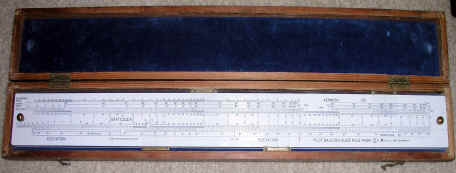Details of the Mark IV.A pilot balloon Slide Rule
The slide rule is intended to be used with a Met. Office Pattern Pilot Balloon Theodolite (Watts Mk IIII or V). The divided gradicule of the theodolite along with the scales provided on the slide rule allow for the use of the tail method for estimate the height of the balloon when strong winds are present (elevation angles of 40 degrees of less). Mark V and Mark 5 slide rules were manufactured after this model.The Mark IV and IV.A were in general use at Meteorological Office stations in the 1960's and 1970's. The Mark IV.A is illustrated below. This model mainly differs from the Mark II in that the stock and sIider, which are 24.5 in (62' 2 cm) long, are made of ivory perspex, or similar plastic material, instead of a wood laminate.
From the Met Office
Texts:
"Meteorological
Office pilot-balloon slide-rule, Mark 4 (Stores Ref., Met.868).- This
slide-rule is the model in current use at Meteorological Office stations. Its
main difference from the Mark 2 model is that the stock and slider, which are
24.5 in. long, are made of ivory perspex, or similar plastic material, instead
of wood. From the illustration in Plate VIII it will be seen that there is a
logarithmic scale, three times repeated and thus covering a range from one to
103, on both the upper and lower edges of the slide. The upper part of the stock
carries two pairs of sine and cosine scales, one pair extending from 0.5 ° to
90° and the other from 10° to 90°; the degrees from 0° to 20° on each
cosine scale are marked on a small arc instead of being crowded together as in
an ordinary slide-rule. A logarithmic scale, twice repeated, and identical with
part of the slider scales, is also provided on the upper part of the stock; this
permits of the rule being used in a limited way as an ordinary slide-rule. The
lower part of the stock has a tangent scale on the right extending from 3 ° to
84.30 and a scale of squares of secants from 0° to 63 ° on the left, the
interval between 40° and 50° on this latter scale being twice that between 40°
and 50° on either of the upper sine and cosine scales. A graticule scale, of
reciprocal logarithms, replaces part of the logarithmic scale on the lower left
part of the slider. Fiducial marks" K ", "Mi/hr", "
1.468" and" f Is" are engraved on the upper part of the stock,
between the main trigonometrical scale and the subsidiary one, for the
conversion of units as explained below.
The general relations used in operating the slide-rule to obtain the height of the balloon h, in feet, the total horizontal distance travelled D, in hundreds of feet, and the easterly and northerly components DE and DN of this distance from the measurements of azimuth A, elevation E and apparent length of the tail m in graticule units are:
h=(kl/m)sin2E=DtanE
D=(kl/m)(1/sec2E)
DE = D sin A and
DN = D cos A ,
where k is the number of graticule divisions per
radian, l the length of the tail in feet, and m its apparent
length in graticule units. Normally the product kl is arranged to be 1.2
X 105. If a different value is used the graticule readings must be
multiplied by 1. 2/kl before calculation on the rule.
In using the slide-rule the normal procedure is first to set the left-hand lower cursor at the observed value of the elevation E on the secant2 scale and to move the slide so that the value of m on the graticule scale is against sec2E. Then, after setting the right-hand lower cursor at the observed elevation on the tangent scale the height is read from the logarithmic scale on the slide. The upper cursors are now set at the observed azimuth on the sine and cosine scales and from these cursors the values of DN and DE are read on the logarithmic scale on the slider. If the value of D is required it can be read from the logarithmic scale opposite sin 90°. Values of the wind components are obtained from the differences of successive values of DN and DE. Then the larger of the components (irrespective of sign) is set at tan 45° on the tangent scale and the reading from this scale against the smaller component gives the angle (less than 45°) between the path of the balloon, in the minute interval concerned, and the nearest of the cardinal lines (W.-E. or S.-N.) bounding the quadrant in question. Finally, with this angle on the sine scale set against the smaller component on the logarithmic scale, the value opposite sin 90° gives the horizontal distance traveled by the balloon in the minute interval, and thus the wind speed in units of 100 ft./min Without further adjustment, the speed may be read off in knots (from the fiducial mark at " K "), in miles per hour (at" Mi/hr ") or in feet per second (at" f/s "). Inter-unit conversions may also be made by direct reading from these fiducial marks. The mark “1•468 " is for conversion from miles per hour to feet per second.
If the observations are made on a moving ship account must
be taken of the ship's course and speed. This is most conveniently done by
adding algebraically the components of the ship's velocity to the components of
the relative wind velocity.
The slide-rule should always be used with care and not
handled with soiled or stained fingers. If it is necessary to clean the surface
warm soapy water should be used. Abrasives, petrol or solvents must never be
used.


